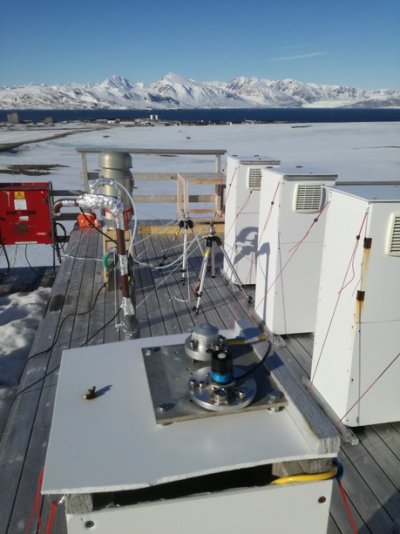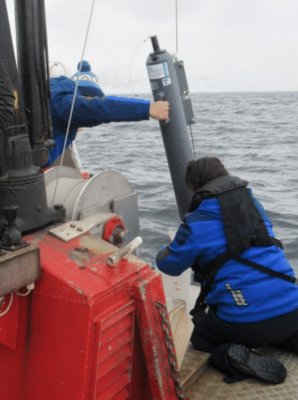The SIOS access project Biogenic Aerosol, oceanic Primary production and Nucleation Events in the Arctic (BioAPNEA) aims to improve the knowledge of the ocean-atmosphere interconnection by investigating the link between measured primary production, sea ice melting, gaseous dimethyl sulphide (DMS) and aerosol methanesulfonic acid (MSA) atmospheric concentration, and the occurrence of New Particle Formation (NPF) events. The project combines in-situ seawater sampling and measurements in Kongsfiorden with atmospheric measurements and sampling in Ny-Ålesund (Gruvebadet and Zeppelin) and is lead by Dr Laura Caiazzo from the Department of Chemistry "Ugo Schiff" at the University of Florence. This is her report from the field.

All the field activities were carried out principally in May and June when the maximum concentration of DMS and MSA occurs, on the basis of previous results. The dataset that will be produced in the framework of this project is composed by a large number of parameters that were measured contemporaneously. The main measured parameters are:
- irradiance in the PAR spectral range and the behaviour of the PAR actinic flux at surface, in the air-sea interface, and under water, in order to estimate the primary production;
- determination of phytoplanktonic biomass, chlorophyll-a concentration, phytoplankton absorption coefficients;
- suspended particulate, pigments, macronutrients, Fe and other oligo elements in sea water;
- photosynthetic performance of phytoplankton surface assemblages;
- gaseous DMS at Zeppelin station;
- MSA and nssSO42- in PM10 sampled at Gruvebadet and their size distribution in the range 0.05 to 10 μm;
- comparison between trace metals (in particular Fe and other oligo elements) in seawater and in PM10 sampled at Gruvebadet;
- aerosol size distribution in the sub-micrometric fraction (10-500 nm) of atmospheric aerosol at Gruvebadet and the number of nucleation events during the field campaign.
On 8th May 2019 the PM10 sampling, already ongoing at Gruvebadet, was increased to daily-resolution (instead of 48 h). This would allow us to see in detail the trend of MSA and especially the maximum peaks in the aerosol, that normally occur in May or June. In order to better understand the seasonal pattern of MSA it is fundamental to also analyse the period before and after its maximum peak. This year was the first time we could collect PM10 samples and see the entire pattern of MSA for one whole year. This work was supported by the National Research Council - Department of Earth System Science and Environmental Technologies (CNR-DTA), who ensured a master's student, Fabio Di Bona, was available for two months to carry out daily aerosol sampling.
On the same day, two radiometers were installed on the roof of Gruvebadet Observatory and started to acquire data. These radiometers are very important to study the radiation SW and PAR in atmosphere.

The original plan was to start water sampling in the same week, but due to a logistical problem we unfortunately were not able to start water sampling until the week after. The best conditions for water sampling are completely clear sky and when a satellite passes overhead and scans the fjord. Unfortunately, in Ny-Ålesund it is difficult to meet these conditions, because the boat Teisten is almost every day booked by researcher groups from other countries. Luckily in June, we were able to work with another Italian group, with whom we shared the CTD data for fluorescence and other parameter measurements, since they chose our same GPR points. We chose two points, one inside the fjord (78°54’N, 12°15’E) in the same spot as the Italian mooring, and one as far outside as possible (78°55’N, 12°13’E), in order to understand if MSA, that comes from DMS in the sea water blooms directly in the water present inside the fjord or from the open ocean.
Unfortunately, on 4th July the sampler for PM10 measurements broke and, as already mentioned, it is important to have measurements also for the coming winter because this would be the second winter that we can collect important information about MSA. For the summer period we will use another kind of filter in order to make up for this problem, but for the next winter we decided to use a third campaign to come back to Ny-Ålesund to have the chance to fix it. So, I returned to N-Ålesund on 14th October until 28th October.
Some of the instruments used are “on-line”, so the related data are already available. Other data need more time, because we need to analyse the PM10 filters and the water samples in our laboratories in Italy. All these data need to be interpreted individually before being put together in order to correlate the factors affecting NPF events in relation with biogenic aerosol formation and sea ice parameters (melting and ice marginal zone extent). This will be useful for interpreting long term DMS and MSA trend and their connection with global change and “Arctic amplification”. The latter result is of particular relevance in the framework of the SIOS observing system as it takes advantage of long-term observational data to interpret change in the Arctic environment. Moreover, it will allow us to design new strategies to fill current knowledge gaps and to propose future prioritisation in optimising the observing system.



























